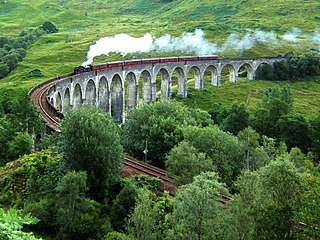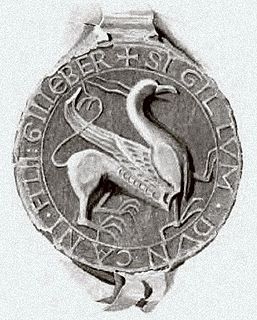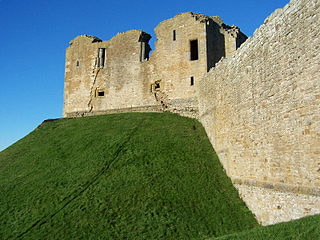Related Research Articles

Badenoch is a traditional district which today forms part of Badenoch and Strathspey, an area of Highland Council, in Scotland, bounded on the north by the Monadhliath Mountains, on the east by the Cairngorms and Braemar, on the south by Atholl and the Grampians, and on the west by Lochaber. The capital of Badenoch is Kingussie.

Lochaber is a name applied to areas of the Scottish Highlands. Historically, it was a provincial lordship consisting of the parishes of Kilmallie and Kilmonivaig, as they were before being reduced in extent by the creation of Quoad Sacra parishes in the 19th century; this Lochaber extended from the Northern shore of Loch Leven, a district called Nether Lochaber, to beyond Spean Bridge and Roybridge, which area is known as Brae Lochaber or Braigh Loch Abar in Gaelic. Lochaber is now also used to refer to a much wider area, one of the 16 ward management areas of the Highland Council of Scotland and one of eight former local government districts of the two-tier Highland region. The main town of Lochaber is Fort William.

Alexander Stewart, Earl of Buchan, Alasdair Mór mac an Rígh, and called the Wolf of Badenoch, was the third surviving son of King Robert II of Scotland and youngest by his first wife, Elizabeth Mure of Rowallan. He was the first Earl of Buchan since John Comyn, from 1382 until his death. Alexander married the widowed Euphemia I, Countess of Ross, but they had no children. He did have a large family by his longtime mistress, Mairead inghean Eachainn. Alexander was Justiciar of Scotia for a time, but not an effective one. He held large territories in the north of Scotland before eventually losing a large part of them. Alexander is remembered for his destruction of the royal burgh of Elgin and its cathedral. His nickname was earned due to his notorious cruelty and rapacity, but there is no proof that it was used during his lifetime.
The Lord of Abernethy was from the 12th century to the 14th century the hereditary holder of the church and lands of the Scottish monastery at Abernethy. It gradually evolved alongside the title Abbot of Abernethy, displacing that term in extant sources by the end of the 13th century. It was held by the descendants of Gille Míchéil, Earl of Fife.
The Earl of Fife or Mormaer of Fife was the ruler of the province of Fife in medieval Scotland, which encompassed the modern counties of Fife and Kinross. Due to their royal ancestry, the earls of Fife were the highest ranking nobles in the realm, and had the right to crown the king of Scots.

Clan MacDuff or Clan Duff is a Lowland Scottish clan. The clan does not currently have a chief and is therefore considered an Armigerous clan, which is registered with the Lyon Court. The early chiefs of Clan MacDuff were the original Earls of Fife, although this title went to the Stewarts of Albany in the late fourteenth century. The title returned to the MacDuff chief when William Duff was made Earl Fife in 1759. His descendant Alexander Duff was made Duke of Fife in 1889.

Donnchadh was a Gall-Gaidhil prince and Scottish magnate in what is now south-western Scotland, whose career stretched from the last quarter of the 12th century until his death in 1250. His father, Gille-Brighde of Galloway, and his uncle, Uhtred of Galloway, were the two rival sons of Fergus, Prince or Lord of Galloway. As a result of Gille-Brighde's conflict with Uhtred and the Scottish monarch William the Lion, Donnchadh became a hostage of King Henry II of England. He probably remained in England for almost a decade before returning north on the death of his father. Although denied succession to all the lands of Galloway, he was granted lordship over Carrick in the north.
Causantín or Constantine of Fife is the first man known for certain to have been Mormaer of Fife.
Mormaer Gille Míchéil is the second man known for certain to have been Mormaer of Fife from 1130 to 1133, although it is unlikely he actually was the second. He had at least one son, called Aed (=Hugh). Aed would have succeeded Donnchad I under a Celtic system, but as feudal rules of primogeniture came into force during the reign of Donnchad I, it was Donnchad's son, and not Gille Míchéil's, who became the next mormaer. Aed, though, probably succeeded to the leadership of Clann Duib, at least during Donnchad I's minority, and certainly became Abbot of Abernethy, an office which his own son, Orm, later inherited.
Donnchad II, anglicized as Duncan II or Dunecan II, succeeded his father Duncan I as Earl of Fife in childhood. As a child of the previous mormaer, he was entitled to succeed his father through primogeniture, but not to lead his kin-group, Clann MacDuib. That probably fell to his cousin, Aed mac Gille Míchéil. Like previous mormaers of Fife, Duncan II was appointed Justiciar of Scotia. Donnchad's minority also meant that Ferchar, Mormaer of Strathearn, took supreme place as head of the Gaelic nobility and guide for the boy-king Malcolm IV.
Moray was a province within the area of modern-day Scotland, that may at times up to the 12th century have operated as an independent kingdom or as a powerbase for competing claimants to the Kingdom of Alba. It covered a different and much larger territory than the modern council area of Moray, extending approximately from the River Spey in the east to the River Beauly in the north, and encompassing Badenoch, Lochaber and Glenelg in the south and west.
The Kingdom of Alba was the Kingdom of Scotland between the deaths of Donald II in 900 and of Alexander III in 1286, which then led indirectly to the Scottish Wars of Independence. The name is one of convenience, as throughout this period the elite and populace of the Kingdom were predominantly Pictish-Gaels or later Pictish-Gaels and Scoto-Norman, and differs markedly from the period of the House of Stuart, in which the elite of the kingdom were speakers of Middle English, which later evolved and came to be called Lowland Scots. There is no precise Gaelic equivalent for the English terminology "Kingdom of Alba", as the Gaelic term Rìoghachd na h-Alba means 'Kingdom of Scotland'. English-speaking scholars adapted the Gaelic name for Scotland to apply to a particular political period in Scottish history during the High Middle Ages.
Mormaer Beth is a name of a Mormaer mentioned in an unreliable charter granted to Scone Priory, later Scone Abbey, by king Alexander I of Scotland.
The Meic Uilleim (MacWilliams) were the Gaelic descendants of William fitz Duncan, grandson of Máel Coluim mac Donnchada, king of Scots. They were excluded from the succession by the descendants of Máel Coluim's son David I during the 12th century and raised a number of rebellions to vindicate their claims to the Mormaerdom of Moray and perhaps to the rule of Scotland.
Fothad II was the bishop of St Andrews (1059–1093) for most of the reign of King Máel Coluim III mac Donnchada. Alternative spellings include Fodhoch, Fothach and Foderoch, and Fothawch. A "Modach filius Malmykel" is mentioned in a grant, dated 1093, as the bishop of S. Andrews. As this bishop is certainly Fothad II, his father was a man named Máel Míchéil.
Máel Dúin is the eighth alleged Bishop of St Andrews. He is mentioned in the bishop-lists of the 15th-century historians Walter Bower and Andrew of Wyntoun as the successor of Bishop Ailín.

Alan Hostarius was the son of Thomas de Lundin, a grandson of Gille Críst, Mormaer of Mar. His mother's name is unknown, but she was almost certainly a daughter of Máel Coluim, Mormaer of Atholl, meaning that Alan was the product of two Gaelic comital families.

Freskin was a Flemish nobleman who settled in Scotland during the reign of King David I, becoming the progenitor of the Murray and Sutherland families, and possibly others.
Adam of Kilconquhar was a Scottish noble from the 13th century. Of Fife origin, he is notable for becoming the husband of the Countess of Carrick and participating in the Ninth Crusade under the command of Lord Edward, Duke of Gascony.
Glencarnie was a provincial lordship in Strathspey, Scotland, co-extensive with the parish of Duthil. It was, alongside Badenoch, Lochaber, The Aird, Stratha'an, Abernethy, Strathbogie and Garioch, one of the eight militarised provincial lordships north of the Mounth that were first documented in the reign of William the Lion and held by families loyal to the crown. These may have been created to secure the Province of Moray during the uprisings of the MacWilliams between 1180 and 1230, or may be the result of an earlier plan to establish royal control over the valley of the Spey dating back to the defeat of Oengus of Moray at the Battle of Stracathro in 1130.
References
- 1 2 Ross 2015, p. 99.
- ↑ Barrow 1988, p. 12.